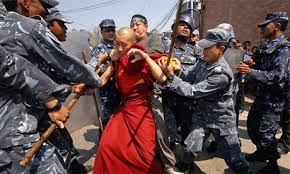
Claire Harvey Source: Supplied
China — what a great place. Fabulous. We love it. Solid friend to Australia. Won’t hear a bad word about the joint.
That, apparently, is the only acceptable opinion nowadays on the great nation to our north.
And when anyone raises even a murmur to the contrary, they’re a moron. A loose cannon. A threat to the balance of trade. Unrepresentative swill. If they have any sense, they’ll apologise quick-smart.
Just to be clear, this is not a defence of Clive Palmer.
It’s just a little note of puzzlement at the way his remarks about the People’s Republic have been almost universally interpreted by people with public voices — from politicians to journalists and academics.
Everyone in the public domain has been rushing to agree with one another in revulsion at the sentiments expressed by Clive and his PUP senator Jacqui Lambie.
Two weeks ago Clive Palmer said the Chinese were “mongrels” and “bastards”, that they operated a totalitarian regime, that they wanted to take Australia’s mineral resources without paying, and that they shot their own people. Palmer subsequently issued a grovelling apology to the Chinese ambassador.
Lambie followed her leader by warning “China is controlled by an aggressive, anti-democratic, totalitarian government. We need to double the size and capacity of our military right now”.
Well, smite me with a bolt of lightning for this heresy — but they’re right, aren’t they? At least half-right?
OK, so both went way too far, and Palmer certainly is hypocritical: he was a big China fan until his mining joint-venture with a state-owned Chinese company turned into an expensive, litigious disaster.

Palmer United Party leader Clive Palmer. Source: News Corp Australia
And it’s very easy to make fun of Lambie, with her scraped-up hair and wacky scarves, her fluency in Hansonese and bossy, exasperated string of non-sequiturs. But why can’t the rest of our politicians momentarily teleport themselves out of whatever Canberra wine bar they’re slurping viognier in, and hear her words as the rest of Australia hears them?
For all Lambie’s flaws, she delivers a line better than Bill Shorten: punchier, snappier, with more cut-through.
Lambie and Palmer’s China rhetoric may sound hysterical to those of us accustomed to more measured mumbling about human rights cough-cough-less-than-ideal-ahem.
But how do they sound to low-wage Australians worried about Chinese workers on 457 visas, or about Chinese investors driving the price of new apartments through the roof?
The truth, no matter how inconvenient, is that China is a totalitarian regime — a repressive place where arbitrary detention, forced relocation, land seizures, official corruption, police and military brutality, religious repression and interference with civil liberties go on every single day.

The Chinese national flag: Picture: Vincent Yu, AP Photo Source: AP
As Palmer said, they do shoot their own people — in an estimated 4000 executions every year — and in the public square. I’m not talking about 1989 and Tiananmen Square.
I’m talking about the five protesters in Tibet shot dead just last week when they dared object to the arbitrary detention of a respected local elder; just a taste of how Beijing reacts to dissent.
So why has it become taboo to admit China’s glaring faults?
Well, we rely on them to buy our exports, to visit our tourist attractions, to fill our universities.
We need their cheap labour to make our $10 T-shirts.
But the bigger, scarier truth is it suits Australia — and the rest of the Western world — for China to continue to oppress its people. Totalitarian regimes may represent evil in its most distilled form, but at least they are stable.
In the Middle East, we’ve seen in the past three years what happens when dictatorships fall.
We all loved the Arab Spring when it was Twitter and dancing in Tahrir Square — finally, a hint of freedom for the millions living under crazed dictatorships.
But the chaos that has followed is a bitter winter. In Iraq, Saddam Hussein’s depravity has been replaced by barbarians without faces, beheading men on their knees.
 The truth, no matter how inconvenient, is that China is a totalitarian regime — a repressive place where arbitrary detention, forced relocation, land seizures, official corruption, police and military brutality, religious repression and gross interference with civil liberties go on every single day.
The truth, no matter how inconvenient, is that China is a totalitarian regime — a repressive place where arbitrary detention, forced relocation, land seizures, official corruption, police and military brutality, religious repression and gross interference with civil liberties go on every single day. 
In Libya, the wicked 42-year reign of Muammar Gaddafi has been replaced by bearded Islamist maniacs dancing on top of burnt-out jumbo jets, declaring themselves the new government. Egypt today is even more of a global beacon for torture and oppression than it was under the dictator Hosni Mubarak.
As for Syria, the monstrous Islamic State controls everything east of Aleppo and is advancing on Damascus, with the likely encouragement of president Bashar al-Assad.
So China, controlled without dissent by the hard old men of the Politburo Standing Committee, is working in Australia’s most cynical interests.
No trade unions — that means our T-shirts are cheaper than ever. No regional independence movements — that means no possible disruptions to two-way trade. No rebel groups turning terrorist.
Australia’s leaders quietly hope China will take baby-steps towards something at least distantly related to democracy, just as long as nobody freaks them out by speaking the truth. Is this really the best we can do in our beautiful haven of free speech?
....



